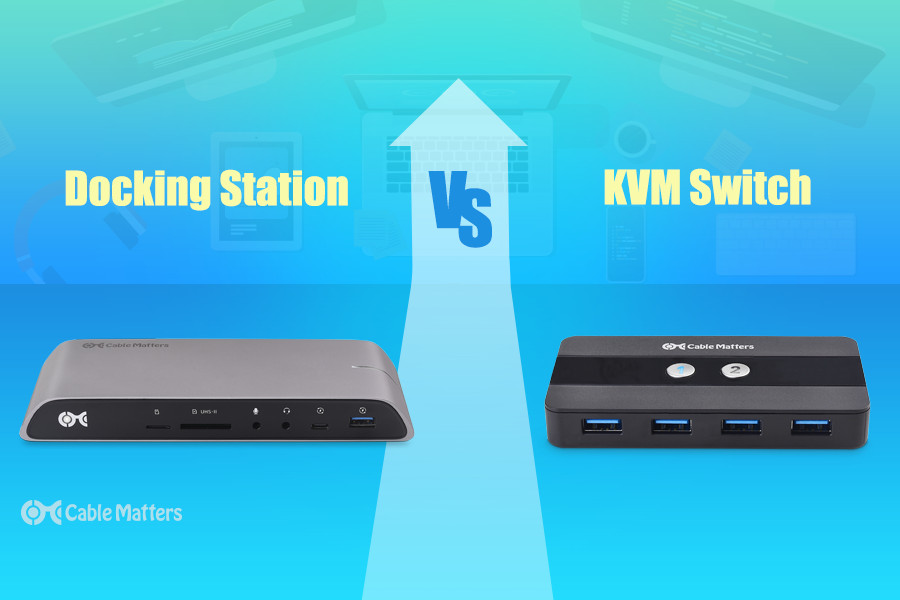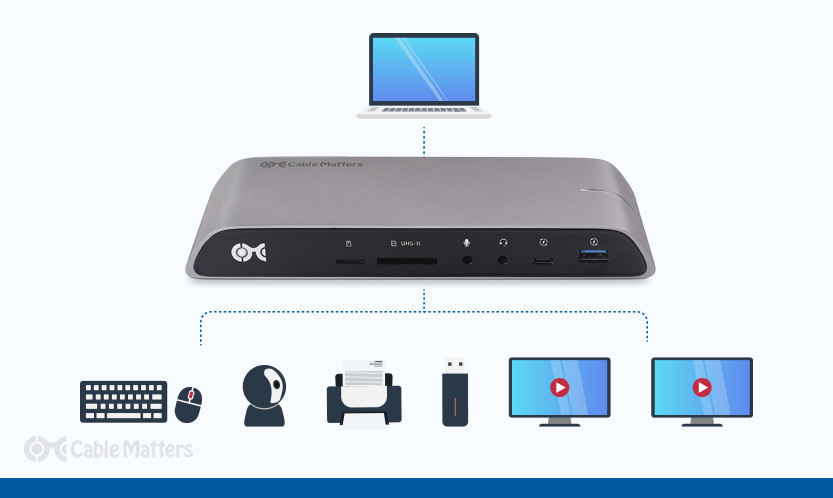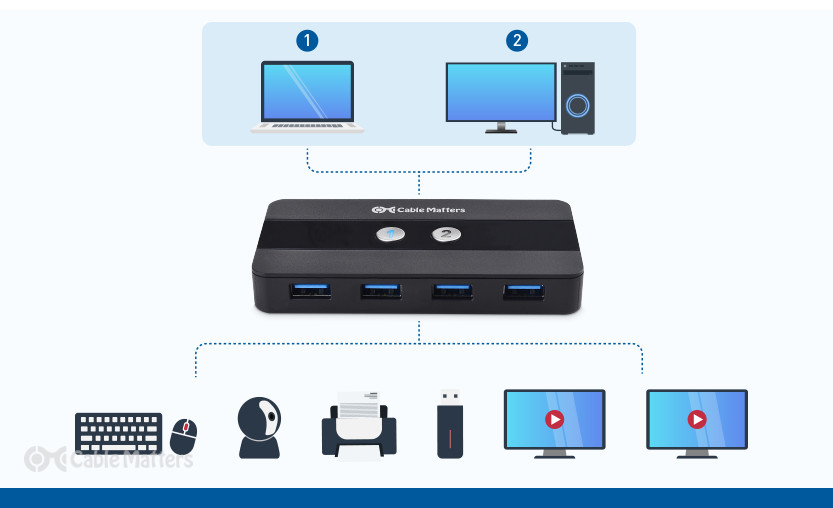
Docking stations and KVM switches are tools designed to tackle different kinds of jobs, but they ultimately both expand the functionality of what you can do on any one device or set of peripherals. They make sure that when you sit down to get some work done, you have access to all of the data, devices, ports, accessories, and networks that you need to complete your most important of tasks.
They’re not standard accessories that come with every laptop or desktop, though, and in the case of KVM switches, are quite niche hardware buys that even seasoned veterans of the IT industry may not have come across before. So learning about the differences between these two important devices and how you can make the most of them is a great way to improve your productivity, whatever kind of work you do.
Here’s a look at docking stations and KVM switches, what makes them different, and how you can make the most of them.
What is a Docking Station?
A docking station is a tool for expanding the functionality and connectivity of laptops. They typically offer a wide array of ports and connections, and in many cases have a mains power connection, so can offer charging via USB-C if your laptop supports it.
Although docking stations have existed for almost as long as laptops in some guise or another, they have really grown in popularity in recent years as modern laptop designs have slimmed down to the point where the number and array of ports and connectors on them has shrunk dramatically. Where once it was common for flagship laptop designs to sport RJ45 Ethernet connections, external display outputs, multiple USB ports, and a full-size card reader, there are many modern designs which feature just a few USB-C ports and not much else.

The ports and connections offered by docking stations can vary dramatically based on size, cost, and quality, but some docking stations come with a vast array of options. This USB-C docking station, for example, sports a Gigabit Ethernet port, four USB-A ports (2 x USB 2.0, 2 x USB 3.0), twin DisplayPort outputs, and a USB-C host port with 80W laptop charging functionality. On the front, it doubles down on its broad array of connectors with a MicroSD and UHS-II SD card reader, twin 3.5mm jacks for headphones and microphone, a USB-C 3.2 Gen 2 port with 18w fast charging with USB Power Delivery, and a USB-A 3.2 Gen 2 port with 10W fast charging functionality.
A docking station like this could hugely expand the hardware options for a modern laptop; especially when it comes to outputting to multiple external displays.
What is a KVM Switch?
A KVM switch is a much more modest, though no-less-useful piece of hardware designed to let you connect multiple systems to a single set of peripherals, usually a keyboard and mouse – hence the abbreviated keyboard, video, and mouse, KVM, naming. Where most desktop PCs and some laptops are operated directly with a keyboard and mouse plugged into their native ports, a KVM switch works by plugging the keyboard and mouse and a number of different systems into the same device. With a press of a button, you can then control which system you’re inputting to at any time.
A typical KVM switch might offer four USB-A 3.0 input ports for connecting various devices, such as a keyboard and mouse, webcam, headset, printer, or scanner, alongside a handful of output connections to connect different devices over USB-C, USB-A, or in some cases, USB-B. It then has some method of switching between the active device, be it buttons on the KVM switch itself, or through a remote control.
In either case, the user has the ability to, at the touch of the button, change which system the attached peripherals are interacting with. This improves productivity when connecting to multiple devices, especially if those same systems are not easily accessible due to being placed in cupboards or racks. It also has a big effect on reducing cable clutter and, ultimately, cost, by cutting back on the number of keyboards and mice that are necessary for managing and utilizing the hardware connected to the KVM switch.
If the user has a particular penchant for a certain keyboard and mouse, such as a favorite mechanical keyboard switch, or a mouse with a saved profile with useful macros, being able to maintain those same preferences across multiple systems and devices can be invaluable.

Is a Docking Station The Same As A KVM Switch?
There is a little crossover between docking stations and KVM switches, but they are fundamentally designed for different tasks.
A docking station is used to expand the array of ports for a single laptop or other mobile device, providing a streamlined charging solution, and giving access to a wider array of external monitors and accessories.
Like a docking station, a KVM switch can give a device access to peripherals it might not otherwise have been able to use, and docking stations can enable the connection of external keyboards and mice which a laptop may not have had access to. Ultimately, though, a docking station is far better at expanding the functionality of a laptop than any KVM switch. That’s why docking stations are primarily used to improve connectivity options for a single laptop and typically aren’t used in conjunction with desktops or servers.
Some KVM switches also offer external monitor support in the form of HDMI, DisplayPort, and USB-C outputs, and the fact that you can connect additional USB peripherals to any connected device to your switch does duplicate docking station inputs to some extent. However, docking stations will, in most cases, offer a greater array of ports, whilst not giving you the option to switch between devices.
KVM switches are predominantly used in environments where there are a large number of systems to manage, such as with multiple desktop PCs – particularly when different operating systems are being used – as well as servers, and datacenters, or when wanting to utilise a laptop with more capable keyboard and mouse combinations that provided with the laptop itself. They are especially useful in the home office, where a company-issued laptop and personal desktop computer may coexist with the same shared set of peripherals and displays.
In some niche cases, there are docking stations which have a KVM switch built-in to them, but they tend to be much more expensive than either individual device, and can connect to fewer devices, whilst providing a more limited selection of ports.
Docking Station vs. KVM Switch: What You’ll Need
To take advantage of a docking station, you only really need the docking station itself and a compatible laptop. Most docking stations come with all the necessary power cables and USB cables to get you up and running and connected. That gives you full access to all ports on the docking station, making it a cinch to plug in an Ethernet cable for wired network access, a USB-A drive for accessing external storage, or additional peripherals like keyboards and mice. If you want to connect an external display, you will need the appropriate DisplayPort, USB-C, or HDMI cable to connect that to the docking station, but assuming that your laptop can send and receive display data over USB-C, you shouldn’t need any kind of additional cable to connect the docking station to your laptop.
Do note, however, that some docking stations that support USB-C may not also have Thunderbolt connectivity, so you may not get the full bandwidth and feature support of Thunderbolt through that docking station, even if your laptop supports it.
For KVM switches, you have even less to worry about. Most KVM switches come with a full complement of USB cables and adapters to help you connect all the systems and hardware you need to take full advantage. The exact cables provided will vary depending on the KVM switch model you choose, though, so be sure to make sure that the model you’ve selected comes with the cables you need.
If you need more cables or adapters for the peripherals or systems you want to connect, then you can use any high quality USB, DisplayPort, or HDMI cables and adapters for the job. Just be sure if buying USB accessories, that you get the right version. USB-A, USB-B, and USB-C are very different and are not interchangeable – hence the necessity for adapters in some cases – but you needn’t worry about USB version. The bandwidth offered by the connection is controlled by the ports at both ends, rather than the cable.
Like some docking stations, there are some KVM switches with external monitor support up to 8K resolution, though not all laptops and desktops can support such resolutions. Apple’s line of MacBook and MacBook Pros, for example, are only able to support a maximum of 4K resolution at 60Hz, making them unable to fully utilize connected 8K or 4K 120Hz displays. Some TVs and monitors may also require firmware updates before displaying properly when connected to a KVM switch.